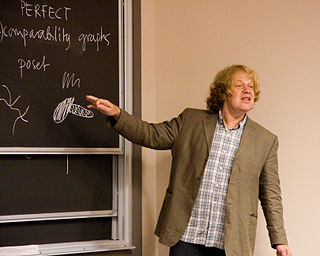Related Research Articles

Edward Witten is an American theoretical physicist and professor of mathematical physics at the Institute for Advanced Study in Princeton, New Jersey.

Tomaž (Tomo) Pisanski is a Slovenian mathematician working mainly in discrete mathematics and graph theory. He is considered by many Slovenian mathematicians to be the "father of Slovenian discrete mathematics."

Richard Kenneth Guy was a British mathematician. He was a professor in the Department of Mathematics at the University of Calgary. He is known for his work in number theory, geometry, recreational mathematics, combinatorics, and graph theory. He is best known for co-authorship of Winning Ways for your Mathematical Plays and authorship of Unsolved Problems in Number Theory. He published more than 300 scholarly articles. Guy proposed the partially tongue-in-cheek "Strong Law of Small Numbers", which says there are not enough small integers available for the many tasks assigned to them – thus explaining many coincidences and patterns found among numerous cultures. For this paper he received the MAA Lester R. Ford Award.

Albert William Tucker was a Canadian mathematician who made important contributions in topology, game theory, and non-linear programming.

In mathematics, topology generalizes the notion of triangulation in a natural way as follows:
George Neil Robertson is a mathematician working mainly in topological graph theory, currently a distinguished professor emeritus at the Ohio State University. He earned his B.Sc. from Brandon College in 1959, and his Ph.D. in 1969 at the University of Waterloo under his doctoral advisor William Tutte.
In mathematics, topological graph theory is a branch of graph theory. It studies the embedding of graphs in surfaces, spatial embeddings of graphs, and graphs as topological spaces. It also studies immersions of graphs.
A gain graph is a graph whose edges are labelled "invertibly", or "orientably", by elements of a group G. This means that, if an edge e in one direction has label g, then in the other direction it has label g −1. The label function φ therefore has the property that it is defined differently, but not independently, on the two different orientations, or directions, of an edge e. The group G is called the gain group, φ is the gain function, and the value φ(e) is the gain of e. A gain graph is a generalization of a signed graph, where the gain group G has only two elements. See Zaslavsky.
Thomas, Tommy or Tom Tucker may refer to:
Claude Jacques Berge was a French mathematician, recognized as one of the modern founders of combinatorics and graph theory.
In graph theory, a voltage graph is a directed graph whose edges are labelled invertibly by elements of a group. It is formally identical to a gain graph, but it is generally used in topological graph theory as a concise way to specify another graph called the derived graph of the voltage graph.

John Robert Stallings Jr. was a mathematician known for his seminal contributions to geometric group theory and 3-manifold topology. Stallings was a Professor Emeritus in the Department of Mathematics at the University of California at Berkeley where he had been a faculty member since 1967. He published over 50 papers, predominantly in the areas of geometric group theory and the topology of 3-manifolds. Stallings' most important contributions include a proof, in a 1960 paper, of the Poincaré Conjecture in dimensions greater than six and a proof, in a 1971 paper, of the Stallings theorem about ends of groups.
James W. Cannon is an American mathematician working in the areas of low-dimensional topology and geometric group theory. He was an Orson Pratt Professor of Mathematics at Brigham Young University.

János Pach is a mathematician and computer scientist working in the fields of combinatorics and discrete and computational geometry.

Michael Jerome Hopkins is an American mathematician known for work in algebraic topology.
In the area of mathematics called combinatorial group theory, the Schreier coset graph is a graph associated with a group G, a generating set {xi : i in I} of G, and a subgroup H ≤ G.
John Rolfe Isbell was an American mathematician, for many years a professor of mathematics at the University at Buffalo (SUNY).
Bojan Mohar is a Slovenian and Canadian mathematician, specializing in graph theory. He is a professor of mathematics at the University of Ljubljana and the holder of a Canada Research Chair in graph theory at Simon Fraser University in Vancouver, British Columbia, Canada.
Alan Curtiss Tucker is an American mathematician. He is a professor of applied mathematics at Stony Brook University, and the author of a widely used textbook on combinatorics; he has also made research contributions to graph theory and coding theory. He has had four children, Katie, Lisa, Edward, and James.
Introduction to Circle Packing: The Theory of Discrete Analytic Functions is a mathematical monograph concerning systems of tangent circles and the circle packing theorem. It was written by Kenneth Stephenson and published in 2005 by the Cambridge University Press.
References
- 1 2 Faculty web page, retrieved 2014-10-29.
- ↑ J. L. Gross and T. W. Tucker, Topological Graph Theory, Wiley Interscience, 1987
- ↑ Thomassen, Carsten (1988). "Review: Topological Graph Theory, by Jonathan L. Gross and Thomas W. Tucker" (PDF). Bull. Amer. Math. Soc. (N.S.). 19 (2): 560–561. doi:10.1090/s0273-0979-1988-15742-4.
- ↑ Thomas William Tucker at the Mathematics Genealogy Project
| This article about an American mathematician is a stub. You can help Wikipedia by expanding it. |